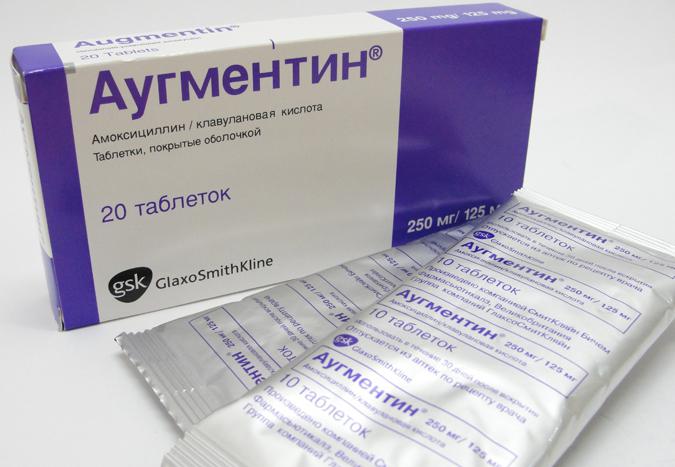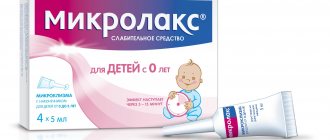During lactation, a woman needs to take care of everything she consumes, since many substances pass into breast milk and can affect the baby. It is especially difficult for young mothers when health problems arise that require antibiotics. Many of them cannot be taken while breastfeeding your baby. Doctors call the drug Amoxiclav safe during breastfeeding. However, it should be taken when feeding a baby with breast milk only after consulting a doctor.
Is it possible to use Amoxiclav while breastfeeding?
The instructions for using the drug do not prohibit taking Amoxiclav during breastfeeding. At the same time, a nursing mother must strictly adhere to the recommendations for the dosage and dosage regimen of the drug in order to avoid negative consequences for the newborn. The conditions for taking Amoxiclav during breastfeeding, although slightly, differ from the standard ones.
It is advisable to take an antibiotic while breastfeeding only if there are serious indications. It is often prescribed for inflammatory diseases that cannot be eliminated without antibiotics: pneumonia, cystitis and other ailments caused by bacterial activity. It is also recommended to use Amoxiclav for bacterial inflammations, when it is important for the mother to avoid infection or cessation of lactation. Most often, the drug is prescribed for mastitis that occurs due to hypothermia or stagnation of milk when the baby is rarely fed breast milk and there is no pumping.
Important! If you have mastitis while breastfeeding, the reason for taking medication is to prevent the formation of an abscess in the mammary gland.
Recommendations on how to take Amoxiclav can be obtained from your doctor. This is the most optimal option, since the specialist will take into account the characteristics of the female body, the age of the child and the intensity of feeding (for example, if the mother has the opportunity to replace feeding the child with breast milk with complementary foods). In any case, before starting to take Amoxiclav when feeding a baby with breast milk, all negative consequences, including allergic reactions in the baby, are taken into account.
Contraindications
Amoxiclav should not be taken during breastfeeding if the mother has the following health problems:
- allergy to cephalosporin and penicillin drugs, even if the reaction occurred in the past;
- sensitivity to other components of the drug - clavulanic acid, components of the tablet form and suspension;
- liver diseases resulting from long-term use of antibiotics;
- violation of the outflow of bile and diseases of the biliary tract in the acute stage;
- mononucleosis - the use of Amoxiclav for this pathology causes a rash similar to measles.
The dispersed form has its own contraindications: phenylketonuria and severe renal failure. When prescribing Amoxiclav to a woman feeding a baby, it is necessary to take into account the listed situations when it cannot be used.
How does Amoxiclav work?
The original description and instructions for use of the drug classify Amoxiclav as a semi-synthetic antibiotic of the penicillin group. The list of active ingredients of the product mentions two substances:
- The semisynthetic antibiotic amoxicillin is the main active ingredient that inhibits bacteria and destroys their membranes.
- Clavulanic acid is an additional bactericidal component that enhances the effectiveness of the drug against beta-lactam bacteria.
The product is effective against many microorganisms. Each component of Amoxiclav is able to penetrate biological fluids and soft tissues within an hour and a half after taking the tablets. When using Amoxiclav in the form of a suspension, active compounds are detected in breast milk even faster - after 30-45 minutes.
In favor of prescribing Amoxiclav during lactation is the fact that the active substances are quickly eliminated from the body through the kidneys and intestines. This means that after completing the course of therapy, you can resume feeding after 12 hours. However, the instructions for use allow nursing mothers to continue breastfeeding without the risk of intoxication. This is important, since in case of mastitis, it is necessary for a nursing mother to maintain lactation during breastfeeding, especially if the baby is not yet 6 months old.
Reviews of women who took the medicine during lactation
Patients say that Amoxiclav almost never causes a negative reaction in the child when breastfeeding. Most often, allergies and digestive disorders occur as a result of improper use of the drug. This is why it is so important to obtain specialist advice and individual prescriptions before correction.
The undoubted advantage of the drug is its varied release form. You can buy capsules or liquid suspension. Remember that the dosage may vary for different types of the drug.
Women note that in addition to safety, the medicine is considered quite affordable. The average cost of one package of the drug is 200 rubles. Most often, a pack of the product is enough for several courses of treatment. Remember that it is quite unsafe to carry out the correction yourself. Treat yourself correctly and be healthy!
Today, treatment with many antibacterial drugs no longer provides the desired effect. Many types of bacteria exhibit resistance (resistance) to the components included in the composition. This leads to the dosage of the drug being increased or the therapeutic course being extended. However, there are aminopenicillins - a group of drugs to which resistance develops very slowly in microorganisms. This group also includes Amoxiclav, a medication to which only 1% of known bacteria are insensitive.
Why you should pay attention to the drug
The use of Amoxiclav has a number of advantages over drugs with similar effects:
- Available in several forms, which allows you to choose the one that is more suitable for the body;
- the medicine is sold at an affordable price;
- has high and stable bioavailability (more than 50%);
- can be consumed both before and after meals;
- amoxiclav not only has a bactericidal effect, but also has a bacteriostatic effect. Thanks to this, not only pathogenic microorganisms are eliminated, but their reproduction is also stopped.
Use for cystitis, urethritis and pyelonephritis
Antibiotic therapy is considered the most effective in the treatment of cystitis, pyelonephritis and urethritis. The dosage of the medicine is selected in accordance with the type, type and dynamics of the development of the pathology.
For cystitis
The drug Amoxiclav for cystitis is highly effective. This is possible due to the fact that the drug is active against gram-positive bacteria that cause inflammation of the bladder. The bactericidal effect of the drug also applies to streptococci, bordetella, salmonella, listeria and echinococcus.
For pyelonephritis
Aminopenicillins are widely used to treat pathology. Amoxiclav provides a good therapeutic effect against enterococci and E. coli. For kidney inflammation at the initial stage, treatment with tablets is possible.
High-quality treatment of pyelonephritis with Amoxiclav is possible due to its high antibiotic properties. In addition, the drug has minimal nephrotoxicity, which affects the condition of the kidneys. Treatment of the inflammatory process in the kidneys and bladder should be accompanied by rapid elimination of the drug. Amoxiclav has this property and leaves the body in high concentrations along with urine.
For urethritis
Amoxiclav helps get rid of urethritis, because... capable of destroying pathogenic microorganisms that cause inflammation of the urethra. An important factor in the treatment of the urethra is the fact that the drug is active against a wide range of microorganisms. Quite often, urethritis is accompanied by genital tract infections, so the ability of Amoxiclav to influence various microorganisms allows you to avoid additional treatment.
How quickly does the medicine take effect?
Amoxiclav is well absorbed and is a fast-acting medicine. Its maximum concentration in the body is observed within 60 minutes after penetration into the bloodstream.
At a time when the maximum saturation of the blood with active substances is expected, it is recommended to monitor the occurrence of undesirable effects. This will allow you to determine the body’s response to the dose of the drug received.
Available forms and main components
Today the drug is available in the following dosage forms:
- film-coated tablets (250, 500, 875 mg);
- powder for preparing a suspension 5 ml (250 and 400 mg);
- soluble powder for intravenous administration (500 and 1000 mg).
Any form of the drug contains as active substances:
- Amoxicillin, included by WHO in the list of the most important existing medicines;
- Clavulanic acid, which helps destroy microorganisms.
Contraindications
The drug should not be prescribed to patients who have:
- intolerance to any component included in the composition;
- high sensitivity to penicillins and other beta-lactam antibiotics;
- lymphocytic leukemia;
- liver dysfunction, the appearance of which was provoked by clavulanic acid or amoxicillin;
- Infectious mononucleosis.
Indications
It is advisable to use Amoxiclav to treat infections caused by sensitive microorganisms:
- urinary tract (with pyelonephritis and urethritis);
- gynecological diseases;
- lesions of the skin and soft tissues;
- bites of humans and animals;
- upper and lower respiratory tract (bronchitis, sinusitis, tonsillitis, pneumonia, chronic otitis media, pharyngitis);
- biliary tract;
- connective tissue and bones.
Intravenous administration of Amoxiclav solution is indicated for therapy:
- abdominal infections;
- infections transmitted during unprotected sex;
- to prevent infection after surgery.
Dosage
For mild to moderate disease, 250 mg tablets are usually prescribed (1 piece every 8 hours). Severe infections are treated by taking 500 mg of the medicine every 12 hours.
The recommended dose depends on the following factors:
- age;
- body weight;
- stages of disease development;
- general condition of the body;
- kidney functioning.
Treatment of cystitis
The daily norm of Amoxiclav for an adult is 625 mg. The dose should be divided into 2 doses. The average duration of the therapeutic course is 3 days.
A longer period of therapy may be prescribed by a doctor if the patient is at risk due to existing diseases and characteristics, which include:
- elevated blood sugar levels;
- male cystitis, occurring in acute form;
- old age (over 65 years);
- metabolic disorders;
- acute forms of pathologies.
During therapy, sexual intercourse and physical activity should be avoided. In some cases, it is appropriate to prescribe a special diet.
Treatment of kidney inflammation
Pyelonephritis is treated for at least 7 days. If therapy is not long enough, there is a risk of leaving the pathology untreated. In some cases, the course is extended to 14 days, but this must be decided by the attending physician, based on test results and the general condition of the patient’s body (especially the kidneys).
Treatment of urethritis
If you have urethritis, you should not use Amoxiclav for more than 14 days. The dosage is selected individually and cannot be the same even for sexual partners.
Overdose
An overdose that occurs requires symptomatic treatment. The patient must be under medical supervision. If the last use of the medicine occurred no later than 4 hours ago, it is advisable to do a gastric lavage and take activated charcoal (reduces absorption).
Side effects
Treatment with Amoxiclav may be accompanied by unwanted side reactions from various body systems.
- the digestive system often reacts with the following manifestations: pain in the epigastric region, impaired liver function, hepatitis, loss of appetite, gastritis, stomatitis, darkening of tooth enamel, stomatitis, cholestatic jaundice, hemorrhagic colitis, glossitis. In older people (usually males), long-term therapy may result in liver failure.
- from the central nervous system, convulsions, dizziness, insomnia, anxiety, and headaches may occur. Most often, such manifestations are observed in people with impaired renal function.
- from the urinary system, hematuria, inflammation of the interstitial tissue and renal tubules, crystalluria are observed;
- allergic reactions manifest themselves in the form of urticaria, itching, angioedema, anaphylactic shock, Stevens-Johnson syndrome, toxic epidermal necrolysis, allergic vasculitis, exudative erythema multiforme.
Pregnancy and children
The active components of the drug tend to pass into breast milk in small quantities. During breastfeeding, it is recommended to suspend treatment with Amoxiclav.
Most often, Amoxiclav therapy is required for children with tonsillitis. The medication prevents the spread of streptococci that cause the disease. The maximum permissible daily dose is 45 mg per 1 kg of body weight. Young children are given the antibiotic to drink in the form of a suspension. An older child (up to 12 years old) is prescribed 40 mg per 1 kg of weight. If the child's weight is more than 40 kg, the daily dose is calculated as for an adult.
The dosage for children cannot be calculated independently. The permissible amount of antibiotic should be calculated by the doctor who prescribed the treatment.
Interaction with alcohol
Like any other antibiotic, Amoxiclav should not be mixed with drinks containing alcohol.
Strong drinks can minimize the therapeutic effect of the drug, but this outcome is not the worst. Mixing with amoxicillin and clavulanic acid, alcohol increases the risk of unwanted side effects several times.
The load on the liver and kidneys increases, which are forced to get rid of not only the breakdown products of the drug, but also the remnants of alcohol. It is recommended to postpone the consumption of alcoholic beverages until the end of the full treatment course.
Sale and price
The drug Amoxiclav is dispensed from pharmacies only with a prescription from a doctor.
Storage
The medication should be kept in a dark, dry place. Storage temperature - no higher than 25 °C. If you follow the recommendations for the contents of the medicine, the shelf life is 2 years.
Reviews
Reviews left by customers indicate the effective action of the drug.
Indications for use of Amoxiclav during breastfeeding
Women's health is somewhat weakened after childbirth, so bacterial infections often increase during breastfeeding. In this case, it is recommended that a nursing mother be treated with safe antibiotics that either do not penetrate into the breast tissue or do not have a significant effect on the baby when breastfed.
The use of Amoxiclav during feeding is effective and safe when using any dosage form. Its active components help eliminate inflammation caused by the activity of bacteria susceptible to penicillins. Lactating women are prescribed medicine for the following diseases:
- inflammatory processes of ENT organs;
- inflammatory processes of the bronchopulmonary system;
- inflammatory diseases of the urinary system;
- inflammatory and purulent diseases of the skin, joints and bones;
- gynecological and infectious sexual pathologies.
Also, the development of inflammatory diseases occurs due to changes in the body. For example, antibiotics are prescribed for lactostasis (milk stagnation) during breastfeeding, which threatens to develop into mastitis. If a similar condition was observed after a previous birth, the patient will be advised to use massage, frequent feeding or expressing milk during lactation.
Note! Despite the proven safety of the drug, only a doctor has the right to prescribe the antibiotic itself and determine its dosage for lactostasis, bronchitis, and cystitis for nursing mothers.
Analogs
If for some reason a woman cannot take Amoxiclav while breastfeeding, the doctor may offer an alternative option from the following list:
- Flemoxin Solutab;
- Flemoklav Solutab;
- Arlet;
- Augmentin;
- Panclave;
- Ecoclave.
Regarding the replacement of Amoxiclav with another medication, you need to contact a specialist, since each of the listed analogues has its own contraindications and side effects.

How to drink Amoxiclav
It is recommended to take Amoxiclav while breastfeeding your baby in the shortest possible course. The doctor selects the minimum effective dosage, based on the patient’s complaints and diagnostic results. Most often, to eliminate unpleasant symptoms during breastfeeding, taking Amoxiclav three times with an interval of 8 hours is sufficient. If necessary, increase the dosage and increase the interval between doses to 12 hours.
Since the components of the drug in maximum concentration are observed in milk 1.5-2 hours after taking the tablets or suspension, you need to use the product so that the peak of this indicator occurs after feeding. To do this, drink the tablets or suspension at least 30-40 minutes before putting the baby to the breast. As a rule, by the next feeding the concentration of active substances in breast milk decreases.
Advice! When using antibiotics, a woman with breastfeeding is advised to drink more so that the kidneys more actively remove the medicine from the body.
Opinion of manufacturers and doctors
Many mothers during the breastfeeding period are very worried about the need to take antibiotics to treat infections. They ask doctors how this can affect the baby’s well-being, whether it will affect lactation and the quality of milk. Manufacturers claim in this regard that there will be no negative reactions from the child’s body if the mother takes Amoxiclav tablets or suspension in a dose that will have a therapeutic effect. And if the benefits to the woman’s health are higher than the expected risks of adverse reactions in the child.
Important! Doctors insist that it is possible to combine Amoxiclav with breastfeeding, and if the woman follows the recommendations on dosage and frequency of administration, nothing bad will happen. The antibiotic is not used for a long course, so doctors insist on continuing breastfeeding. After all, mother’s milk is a source of vitamins and substances necessary for the full development and health of the baby.
Dosages of Amoxiclav for nursing mothers
The standard dosage of Amoxiclav tablets or suspension when feeding with breast milk is 125 mg per dose. A woman is allowed to drink no more than 2 tablets per day. If no pronounced reactions to the drug are observed, but the symptoms are severe, the single dose is increased to 250 mg.
As for cases where the disease is severe, the instructions for lactation allow for an even greater increase in the single dose to 500 mg, and the interval between doses is increased to 12 hours. For mastitis with or without suppuration, the drug is taken for at least 2 weeks, 500 mg three times a day, and for complicated cases, 875 mg three times a day.
The duration of the course and other features of taking Amoxiclav are discussed individually. So, for cystitis, a 5-day course of treatment is sufficient, while for sore throat and mastitis, the dose of antibiotic prescribed by the doctor should be taken for at least 10-14 days.
Important! To prevent changes in the intestinal microflora in the mother, you should start taking Bifiform, Linex, Hilak Forte and their analogues along with the antibiotic.
Release form of the medicine
Amoxiclav is sold in pharmacies in the form of tablets and powder, from which a solution is prepared for oral administration and injection. In tablet form, it is recommended to dilute the product with boiled water in an amount of 100-150 ml. Tablets are available in different dosages of amoxicillin, the active ingredient, so they can contain 125, 250, 400, 500, 875 and 1000 mg of the active substance.
To summarize, we can list the release forms of Amoxiclav:
- tablets 250+125 mg, 500+125 mg, 875+125 mg (amoxicillin + clavulanic acid);
- powder for the preparation of oral suspension – 125+31 mg, 250+62 mg, 400+57 mg, 600+42 mg;
- powder for the preparation of intravenous solutions – 500+100 mg, 1000+200 mg;
- tablets for resorption in the mouth without swallowing – 500+125 mg, 875+125 mg.
On a note! The manufacturer indicates the amount of clavulanic acid in the drug separately. That is, if the package indicates the total amount of Amoxiclav 156 mg, then you need to take into account that the content of clavulanic acid is 31 mg, and the rest is amoxicillin.

Consequences for the child
When taken correctly, the drug is quickly eliminated from the body, so its active compounds do not have time to have a negative effect on the baby’s body. However, despite this, sometimes there are unpleasant consequences for the child, which are typical for antibiotics. Among them:
- thrush in the mouth;
- dermatitis and allergies;
- discomfort in the intestines.
In order to promptly identify side effects in your baby, it is important to monitor his condition and mood. Frequent crying, pulling the legs towards the stomach, rumbling and diarrhea should alert you and be a reason for a visit to the pediatrician. Children's medications to restore microflora help eliminate these symptoms.
When allergic reactions occur, the child may become anxious due to itching of the skin, swelling of the nasal mucosa, and so on. Upon careful examination, red rashes or even papules may be found on the body. In this case, you need to consult a pediatrician or dermatologist, who can prescribe external medications or children's allergy drops/sprays.
As numerous reviews indicate, the antibiotic Amoxiclav quickly copes with infections in the body of a nursing mother. Fears for the baby’s condition are often unfounded, since the risk of side effects when taken correctly is extremely low.
Is it possible to take Aminoxylav while breastfeeding?
Results from an Israeli study suggest that amoxicillin/clavulanic acid and cefuroxime may be safe during lactation. Larger studies are needed to confirm these results [1] .
Possible consequences for the child
Since Amoxiclav belongs to the group of antibiotics, it is important to monitor the baby’s well-being. In most cases, no reactions to the drug occur; side effects most often occur when the dosage is exceeded. However, a nursing mother should find out the possible consequences for the child:
- the appearance of thrush in the oral cavity;
- indigestion, diarrhea;
- allergic rash.
In a small, controlled, prospective study, mothers monitored their children for signs of side effects (furred tongue, difficulty feeding, changes in stool frequency and consistency, diaper rash, and skin rash). There were no statistical differences in these parameters between the infants of control mothers and the 14 mothers taking amoxicillin-clavulanate. [2]
When should you not take the drug?
Amoxiclav is not prescribed if a woman has:
- allergic reaction to penicillins and cephalosporins in the past;
- intolerance to the components of the drug;
- impaired bile secretion and liver pathology caused by taking antibiotics;
- mononucleosis: taking an antibiotic can cause a measles-like rash.
The dispersed form of the drug has additional restrictions on administration:
- phenylketonuria;
- severe form of renal failure.
The drug is used with caution in the presence of diseases of the digestive organs, liver pathology, pseudomembranous colitis.
Is it possible to feed a child during treatment?
Amoxiclav is part of the group of antibiotics allowed during breastfeeding. There is no need to switch your baby to artificial formula. It is permissible to refuse to feed the baby only in two cases:
- if the baby is intolerant of the drug;
- if the mother is prescribed large doses of antibiotics.
However, in both cases, consultation with a specialist is required to resolve the issue individually.











